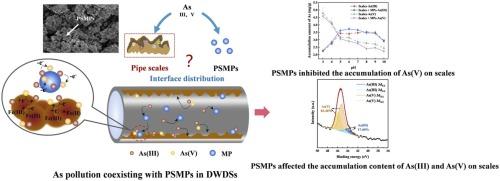聚苯乙烯微塑料对金属砷(Ⅲ)和砷(Ⅴ)在饮用水输配系统管道尺度上的分布行为和机制的影响
IF 11.3
1区 环境科学与生态学
Q1 ENGINEERING, ENVIRONMENTAL
引用次数: 0
摘要
长期以来,管垢一直被认为是饮用水输配系统(DWDS)中痕量重金属的主要吸附介质。微塑料(MPs)可能会影响金属砷(As)污染物在饮用水输配水系统中的分布。本文研究了在不同水质条件下,As(Ⅲ)和As(V)在管道鳞片和聚苯乙烯微塑料(PSMPs)上的累积行为。此外,还研究了As(Ⅲ)和As(V)在与聚苯乙烯微塑料共存的管道鳞片上的累积行为。结果表明,管道鳞片对 As 的积累起着关键作用(管道鳞片 = 1.08-4.80 mg/g >;PSMPs = 0.02-3.38 mg/g)。As(Ⅲ) 在 PSMPs 上的吸附量高于 As(V)。在 pH = 3-8 时,PSMPs 的加入促进了 As(Ⅲ)在管垢上的积累,而在 pH = 3-10 时,由于竞争吸附作用,抑制了 As(V)在管垢上的积累。在 As(Ⅲ) 和 As(V) 在管道鳞片上累积的过程中,As(Ⅲ) 被氧化,As(V) 被还原。值得注意的是,积聚在管道鳞片上的 PSMPs 有利于 As(Ⅲ)的氧化,从而有可能降低与 As 有关的风险。总之,我们的研究结果为了解 DWDS 中 MPs 的危害提供了新的视角。本文章由计算机程序翻译,如有差异,请以英文原文为准。


Effects of polystyrene microplastics on the distribution behaviors and mechanisms of metalloid As(Ⅲ) and As(V) on pipe scales in drinking water distribution systems
Pipe scales have long been considered the primary adsorption medium for trace heavy metals in drinking water distribution systems (DWDSs). Microplastics (MPs) potentially affect the distribution of metalloid arsenic (As) pollutants in DWDSs. Herein, the accumulation behaviors of As(Ⅲ) and As(V) on pipe scales and polystyrene microplastics (PSMPs) under different water conditions were studied. Additionally, As(Ⅲ) and As(V) accumulation behaviors on pipe scales coexisting with PSMPs were investigated. Results showed that pipe scales played a key role in the accumulation of As (pipe scales = 1.08–4.80 mg/g > PSMPs = 0.02–3.38 mg/g). The adsorption amount of As(Ⅲ) on PSMPs was higher than that of As(V). The addition of PSMPs promoted the accumulation of As(Ⅲ) on pipe scales at pH = 3–8 while inhibiting the accumulation of As(V) on pipe scales at pH = 3–10 due to the competitive adsorption. The oxidation of As(III) and the reduction of As(V) occurred during the accumulation of As(Ⅲ) and As(V) on pipe scales. Notably, PSMPs accumulated on pipe scales were beneficial to the oxidation of As(Ⅲ), potentially reducing the As-related risks. Overall, our results provide new insights into the hazards posed by MPs in DWDSs.
求助全文
通过发布文献求助,成功后即可免费获取论文全文。
去求助
来源期刊

Journal of Hazardous Materials
工程技术-工程:环境
CiteScore
25.40
自引率
5.90%
发文量
3059
审稿时长
58 days
期刊介绍:
The Journal of Hazardous Materials serves as a global platform for promoting cutting-edge research in the field of Environmental Science and Engineering. Our publication features a wide range of articles, including full-length research papers, review articles, and perspectives, with the aim of enhancing our understanding of the dangers and risks associated with various materials concerning public health and the environment. It is important to note that the term "environmental contaminants" refers specifically to substances that pose hazardous effects through contamination, while excluding those that do not have such impacts on the environment or human health. Moreover, we emphasize the distinction between wastes and hazardous materials in order to provide further clarity on the scope of the journal. We have a keen interest in exploring specific compounds and microbial agents that have adverse effects on the environment.
 求助内容:
求助内容: 应助结果提醒方式:
应助结果提醒方式:


